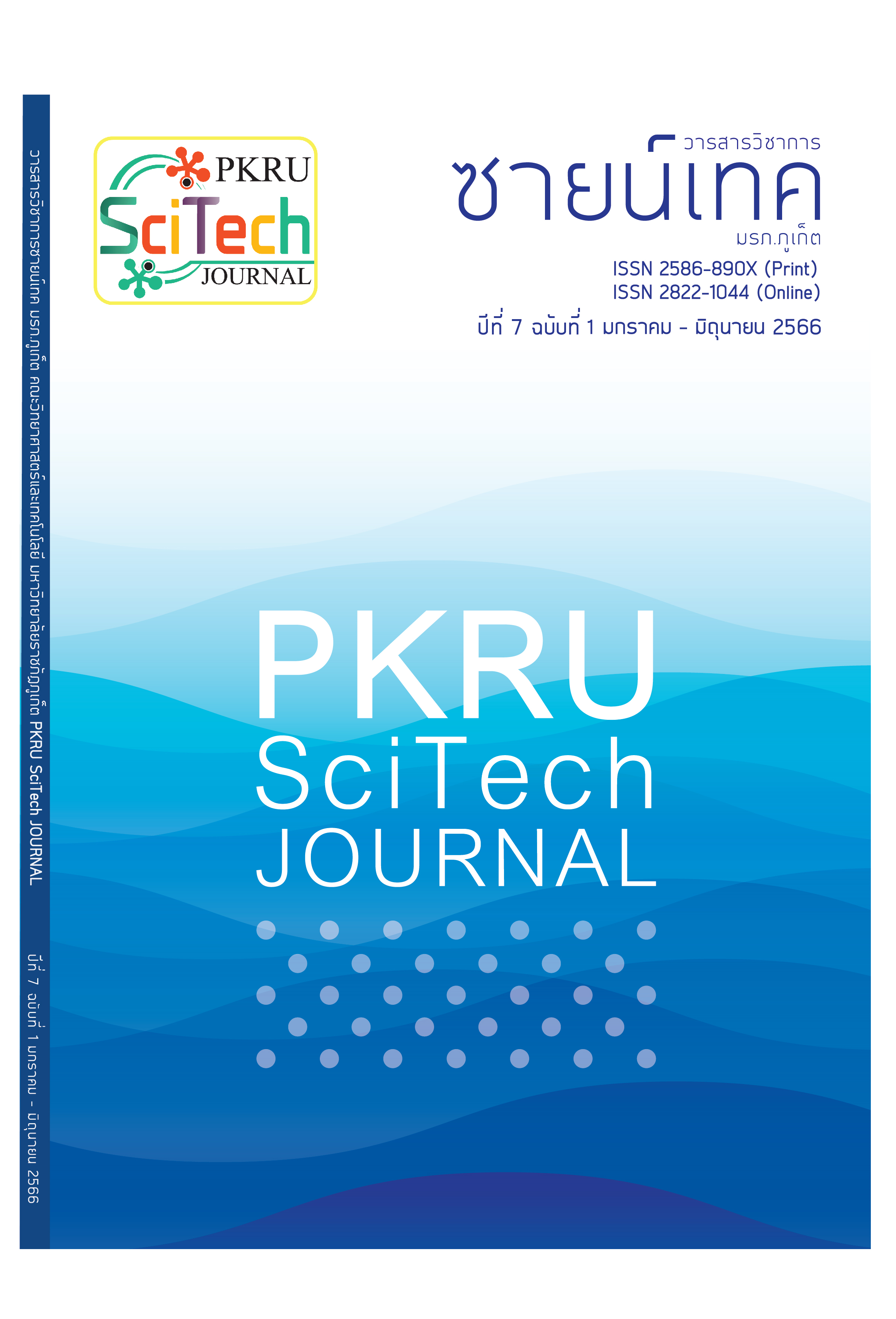Embryo development of Acropora aspera (Dana, 1846) at Tang-Khen Bay, Phuket Province
Main Article Content
Abstract
Each coral species shows variation in the embryo development period. Therefore, development stage studies help to understand the dispersal potential and dynamics of coral populations in each species and each region. In addition, the information obtained should help coral reef management and restoration plan. The objective of this study was to study the embryonic development of Acropora aspera. Corals with mature eggs from Tang-Khen Bay, Phuket, were acclimated in a large naturally lighted outdoor laboratory aquarium system to record the spawning time and larval development periods. This study was conducted in July-August 2021. Acropora aspera was found to be a hermaphroditic broadcasting and spawning 5-7 days after the full moon. It begins approximately 2 hours after sunset. Then, the fertilized zygote starts to divide into stage 2 blastomeres 2.30 hours after release of the gametes into the seawater. The embryo enters the gastrula stage within 14.30 hours after spawning, ending the first stage of development. Later, at 37.30 hours, the early planula appeared, which is the beginning of the larva stage. The elongate planula takes a total of 67.30 hours to develop. The planula swims near the seawater surface for ≈ 24 hours. After that, they descend and settle on the substrate within 6 days after spawning.
Article Details

This work is licensed under a Creative Commons Attribution-NonCommercial-NoDerivatives 4.0 International License.
- The original content that appears in this journal is the responsibility of the author excluding any typographical errors.
- The copyright of manuscripts that published in PKRU SciTech Journal is owned by PKRU SciTech Journal.
References
Harrison, P. L., & Wallace, C. C. (1990). Reproduction, dispersal and recruitment of scleractinian corals (pp. 133-207). In Dubinsky, Z. (ed). Coral reef ecosystem. Elsevier, Amsterdam.
Harrison, P. L. (2011). Sexual reproduction of scleractinian corals (pp. 59-85). In Dubinsky, Z. & Stambler, N. (eds). Coral reefs: and ecosystem in transition. Springer, Dordrecht.
Ball, E., Hayward, D., Reece-Hoyes, J., Hislop, N., Samuel, G., Saint, R., Harrison, P., & Miller, D. (2002). Coral development: from classical embryology to molecular control. The International Journal of Developmental Biology, 46, 671-678.
Toh, T. C., Guest, J., & Chou, L. M. (2012). Coral larval rearing in Singapore: observations on spawning timing, larval development and settlement of two common scleractinian coral species. Contributions to Marine Science. National University of Singapore, Republic of Singapore.
Harrison, P. L., Babcock, R. C., Bull, G. D., Oliver, J. K., Wallace, C. C., & Willis, B. L. (1984). Mass spawning in tropical reef corals. Science, 223, 1186-1189.
Figueiredo, J., Baird, A. H., & Connolly, S. R. (2013). Synthesizing larval competence dynamics and reef-scale retention reveals a high potential for self-recruitment in corals. Ecology, 94, 650-659.
Ritson-Williams, R., Arnold, S. N., Fogarty, N. D., Steneck, R. S., Vermeij, M. J., & Paul,
V. J. (2009). New perspectives on ecological mechanisms affecting coral recruitment on reefs. Smithsonian Contributions to the Marine Sciences, 38, 437-457.
วิภาดา ลลิตภัทรกิจ, ปฐพร เกื้อนุ้ย, สุชนา ชวนิชย์, และวรณพ วิยกาญจน์. (2558). การพัฒนาระยะต้นของตัวอ่อนปะการัง Pocillopora damicornis (Linnaeus, 1758) และ Acropora millepora (Ehrenburg, 1834) บริเวณหมู่เกาะแสมสาร จังหวัดชลบุรี (หน้า 1565-1574). ใน การประชุมหาดใหญ่วิชาการระดับชาติ ครั้งที่ 6. มหาวิทยาลัยหาดใหญ่.
Okubo, N., & Motokawa, T. (2007). Embryogenesis in the reef-building coral Acropora spp.. Zoological Science, 24, 1169-1177.
Okubo, N. (2016). Restructuring the traditional suborders in the order Scleractinia based on embryogenetic morphological characteristics. Zoological Science, 33, 116-123.
Randall, C. J., Negri, A. P., Quigley, K. M., Foster, T., Ricardo, G. F., Webster, N. S., Bay, L.K., Harrison, P. L., Babcock, R. C., & Heyward, A. J. (2020). Sexual production of corals for reef restoration in the Anthropocene. Marine Ecology Progress Series, 635, 203-232.
Gilmour, J. (1999). Experimental investigation into the effects of suspended sediment on fertilisation, larval survival and settlement in a scleractinian coral. Marine Biology, 135, 451-462.
Fadlallah, Y. H. (1983). Sexual reproduction, development and larval biology in scleractinian corals. Coral reefs, 2, 129-150.
Wallace, C. C. (1985). Reproduction, recruitment and fragmentation in nine sympatric species of the coral genus Acropora. Marine Biology, 88, 217-233.
Ward, S., & Harrison, P. (2000). Changes in gametogenesis and fecundity of acroporid corals that were exposed to elevated nitrogen and phosphorus during the ENCORE experiment. Journal of Experimental Marine Biology and Ecology, 246, 179-221.
Hayashibara, T., Ohike, S., & Kakinuma, Y. (1997). Embryonic and larval development and planula metamorphosis of four gamete-spawning Acropora (Anthozoa, Scleractinia) (pp 1231-1236). In Proceedings of the 8th International Coral Reef Symposium. Panama.
Bassim, K., Sammarco, P., & Snell, T. (2002). Effects of temperature on success of (self and non-self) fertilization and embryogenesis in Diploria strigosa (Cnidaria, Scleractinia). Marine Biology, 140, 479-488.
Woolsey, E. S., Byrne, M., & Baird, A. H. (2013). The effects of temperature on embryonic development and larval survival in two scleractinian corals. Marine Ecology Progress Series, 493, 179-184.
Vermeij, M. J. A., Fogarty, N. D., & Miller, M. W. (2006). Pelagic conditions affect larval behavior, survival, and settlement patterns in the Caribbean coral Montastraea faveolata. Marine Ecology Progress Series, 310, 119-128.
Jones, R., Ricardo, G. F., & Negri, A. P. (2015). Effects of sediments on the reproductive cycle of corals. Marine Pollution Bulletin, 100, 13-33.
Harii, S., Nadaoka, K., Yamamoto, M., & Iwao, K. (2007). Temporal changes in settlement, lipid content and lipid composition of larvae of the spawning hermatypic coral Acropora tenuis. Marine Ecology Progress Series, 346, 89-96.
Richmond, R. H. (1987). Energetics, competency, and long-distance dispersal of planula larvae of the coral Pocillopora damicornis. Marine Biology, 93, 527-533.
Miller, K., & Mundy, C. (2003). Rapid settlement in broadcast spawning corals: implications for larval dispersal. Coral reefs, 22, 99-106.


